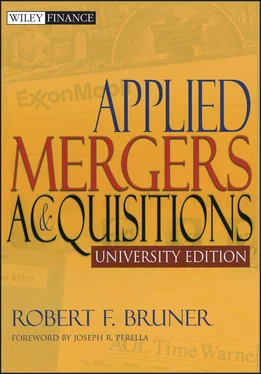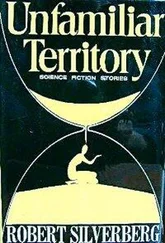Law. The matrix of laws and regulations in the business environment constrain the actions of the buyer and target firms and of specific players such as CEOs, directors, accountants, analysts, and insiders. The businessperson must ask, “What is our legal exposure in this situation and how can we manage it?” Chapters 26through 29explore the structural influence of laws and regulations in M&A.
Ethics. In the professional literature on M&A, very little has been written about ethical dilemmas. Yet practitioners struggle through these virtually daily. Chapter 2argues that the best practitioners consciously address the ethical dimension in deal development and assiduously avoid taint that might accrue from an ethical lapse.
To focus only on structure is to be a determinist: “If X is the condition, Y is the outcome.” Yet to be a determinist is to settle for a limited view of the world. Causality might be more complicated than initially believed, as the followers of Karl Marx and Sigmund Freud discovered. Human behavior is uncertain . This uncertainty muddies the causal effects of structure. For instance, a machine can hit a tennis ball over the net with great predictability. Humans, on the other hand, are less predictable—differences in skill, strength, and strategy can force opponents to make bets about the behavior of each other. Such is also the case in M&A, a game in which one’s conduct has a large influence on outcomes. Conduct intervenes in the pursuit of good outcomes anytime one must make a strategic choice or adopt tactics for behavior. In short, best practice requires that we augment the deterministic focus on structure with a probabilistic focus on conduct, in areas such as the following:
Search for partners. Chapter 6argues that the search for acquisition targets is one part structured research and another part serendipity: In the modern jargon, good discovery relies on networking, which itself relies on social skills that are not readily given to deterministic description.
Due diligence. This is the structured search for risk. Here again, we have a discovery process that depends on both organized inquiry and agile thinking. Chapter 8argues that due diligence is least successful when reduced to rote fact checking. Instead, the right way to discover hidden risks is to research curious details, anomalies, inconsistencies, and discontinuities—all under tight time pressure and efforts by the seller to put a gloss on things. Here, the uncertainty of conduct arises from the investigator’s stamina, care, and capacity for critical thinking.
Negotiation and bidding. The probabilistic influence of psychology and self-discipline appear most vividly in settings where M&A parties grapple with one another. Chapter 30reviews research that shows that attitudes, appetites, and negotiation tactics have a large influence on deal prices and terms. Chapter 31shows that auctions and deal frenzy can prompt a bidder to make an offer beyond the rational maximum—this results in the “winner’s curse.” Chapters 32and 33emphasize that hostile takeovers are games in which psychology and beliefs about competitors have huge influences on the step-by-step movements of the competitors.
Dealing with laws, regulations, and the judicial system. Laws and regulations may seem like constraints on actions, though to the artful practitioner they may raise new opportunities and/or mitigate threats. Lobbying regulators and legislators and appealing to the courts for relief are means by which the practitioner might actually shape the structure of the M&A situation. Chapters 26through 29, 32, and 33survey the dimensions in which laws, regulations, and the courts may affect M&A conduct.
Deal design. Chapters 18and 25frame the deal design effort as a search for trade-offs that can accumulate to a winning outcome for both buyer and target, the so-called win-win deal. This search is yet another discovery process, more like a dance than an engineering problem. And as dancers know, it takes skill and coordination to come to an end with graceful bow and applause rather than stumbles and embarrassed gasps.
Postmerger integration. William Blake once said, “Execution is the chariot of genius.” No matter how good the deal design, implementing the merger integration is where the hypothesized deal benefits are won or lost. Choosing the right integration strategy is a matter of judgment; implementing it well is a matter of managerial skill. Chapter 36argues that acquisitions trigger fear and anxiety among employees in the target firm and that these emotions can torpedo efforts to realize benefits from the deal.
Leadership and communication. As adept public speakers know, it is not merely what you say, but also how you say it, that counts. Differences in expression are some of the most subtle and powerful ways in which conduct can intervene in the realization of outcomes. Communication issues permeate the deal process. This book addresses them in numerous areas, including ethics ( Chapter 2), deal search ( Chapter 7), due diligence ( Chapter 8), accounting ( Chapter 16), social issues ( Chapter 24), disclosure to markets ( Chapter 27), negotiation ( Chapter 30), auctions ( Chapter 31), hostile takeovers ( Chapters 32and 33), the presentation of proposals ( Chapter 35), postmerger integration ( Chapter 36), and the leadership of the deal process ( Chapter 37).
Managing the deal development process. A special perspective of this book is an emphasis on the importance of good process as one of the key drivers of good outcomes. Best practitioners make deal management into a strategic capability. Process lends discipline to one’s thinking, fights the psychological trap of deal frenzy, and helps to motivate the creative search for solutions to thorny problems. How one might structure good M&A process is the subject of discussion in chapters on deal search (7), due diligence (8), valuation (9), deal development (25), negotiation (30), communication (35), and best practice (38).
The final element of the structure-conduct-outcomes framework is outcomes , the whole point of the M&A effort. Quite simply, this could be measured in terms of the fulfillment of one’s intentions for doing the deal. The thoughtful practitioner will benchmark the deal’s outcomes against at least seven measures:
1 Creation of market value. As Chapter 9suggests, one needs to think like an investor, which means harnessing the perspective of the providers of capital. The creation of market value is measured straightforwardly by the change in share values, net of changes in the stock market.
2 Financial stability. Some of the saddest M&A deals are those that, rather than making the buyer stronger, actually destabilize it. In most of these cases, the buyer overreaches its financial capacity. Financial stability can be measured by changes in debt ratings, default risk, or other measures of financial capacity outlined in Chapters 13and 20.
3 Improved strategic position. Many M&A transactions are motivated by a strategic purpose that seeks to improve the firm’s competitive position, acquire new capabilities, improve agility, or obtain resources that are vital to future prosperity. Chapter 6sketches these considerations. Also, many deals respond directly to turbulent forces in the firm’s environment—these are surveyed in Chapters 4and 5.
4 Organizational strength. Knitting together two firms is especially challenging from an organizational perspective. Most CEOs would agree with the old slogan “People are our most important asset.” Chapters 36and 37survey what this might mean in practice. In essence, one could measure organizational strength in terms of depth of talent and leadership, effectiveness of business processes, and the transmission of culture and values.
5 Enhanced “brand.” The deal should improve the reputation of the acquirer and its deal architects. Usually, the realization of these other aims will do just that. But one can imagine deals that depend on acrimony, subterfuge, and win-lose mentality—in a world of repeated play, the executive must consider how these qualities might affect one’s M&A success in future deals.
Читать дальше












